The terrain section of the Codex provides information and background on the types of Terrain found within the game, including statistics and effects on Movement. There is a unique description and portrait for each biome: Grass, Desert, Ice, and Volcano.
There is a total of 13 entries in the Terrain codex.
Codex Entries[edit]
| Grass Road
|
Snow Road
|
| A stone road, warmed in the summer sun. Its solid surface has been worn smooth by decades of use.
|
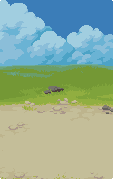
|
A road running through snowy wastes. Here and there, its surface gives way to the elements, cracked stone besieged by relentless ice. In between, the way is smooth, worn flat by the feet of the living and the undead alike.
|
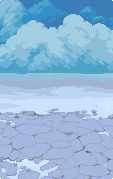
|
| Desert Road
|
Volcanic Road
|
| A bright road that cuts a dependable path through the shifting dunes of the desert.
|
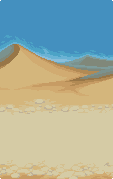
|
A weary road, aged and smooth, and hot to the touch. A worn but dependable pathway through inhospitable terrain.
|
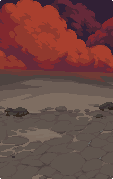
|
| Road
|
| Strategy
|
Roads provide no defence, but allow Wagons to move at fantastic speeds across the battlefield. Blocking a road can greatly restrict the movement of enemy units, leading to a positional advantage.
|
| Statistics
|
Stone roads speed along big wooden wheels, but offer little protection.
|
| Grass Plains
|
Snow Plains
|
| On sunny days, the verdant grassland comes alive with the buzzing song of grasshoppers. Above, swallows swoop through the warm air.
|
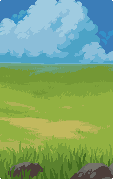
|
Icy tundra, bright and quiet. Underfoot, thick snow crunches, and the air around is chill.
|
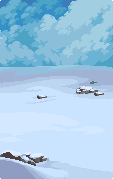
|
| Desert Plains
|
Volcanic Plains
|
| Glistening sands sweep in soaring drifts, lit golden bright by the desert sun.
|
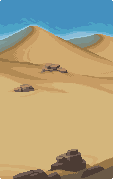
|
The ground is thick with ash upon these barren plains. Cinders rise in murky clouds from underfoot, while deep below, bright embers glow.
|
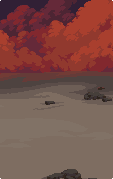
|
| Plains
|
| Strategy
|
Plains offer a basic level of defence whilst remaining generally accessible to all ground units.
|
| Statistics
|
Whilst accessible to all units, plains provide little defence.
|
| Grass Forest
|
Snow Forest
|
| Tangled roots and thick ferns grow in abundance in this lush forest. The dense canopy above casts cool shadows between the trees.
|
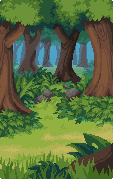
|
The limbs of these aged trees hang heavy with snow. The deep green richness of their needles remain lush beneath the icy white.
|
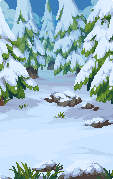
|
| Desert Forest
|
Volcanic Forest
|
| Desert grasses thrive in the loose, shaded earth between the trees and cacti. Insects hum among the blades, and tiny lizards cling to the gnarled tree trunks, sunning themselves in the desert heat.
|
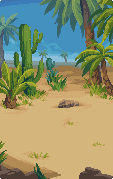
|
The wasted skeletons of once-verdant trees cluster together, There are embers in the air, and the ambient heat nurses the wood to flame.
|
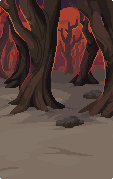
|
| Forest
|
| Strategy
|
Though they don't offer defence that quite matches that of the mountains, forests are a little easier to traverse, and remain accessible to Cavalry. With the exception of Dogs and Turtles, units are unable to see into forests during fog of war unless they are in an adjacent tile. This makes them the perfect place to set up an Ambush.
|
| Statistics
|
Forests make for slow going, but provide good defence and a potential means of avoiding vehicles.
|
Mountain[edit]
| Grass Mountain
|
Snow Mountain
|
| Alpine grasses thrive in the damp, cool air of the mountains, nestled in loose earth between jagged rocks.
|
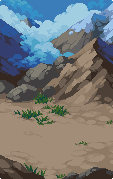
|
Craggy, ragged peaks blasted by the freezing snow. Rough, unsteady footing made treacherous by the perilous ice.
|
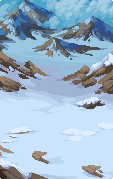
|
| Desert Mountain
|
Volcanic Mountain
|
| Mountain peaks worn smooth by sand. In a high wind, the whole landscape seems to shift and resettle.
|
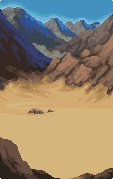
|
These mountains rise in ragged ranges, each peak a desolute monument to the monstrous power of the earth.
|
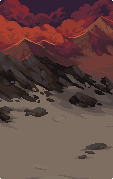
|
| Mountain
|
| Strategy
|
Whist difficult to traverse, mountains provide the most defensive position available for those units capable of climbing them. Mountains are of particular importance during fog of war, where they increase the sight range of occupying units.
|
| Statistics
|
Accessible only to footsoldiers, Dogs and air units. A good defensive terrain, but one that slows unit movement.
| Stats
|
| Defence: 4
|
3  1 1 
|
|
| Grass River
|
Snow River
|
| Sparkling water meanders lazily across the land. Flickering shafts of sunlight pierce the clear water, dancing across the scales of tiny, flitting fish that dwell in the shallow coolness.
|
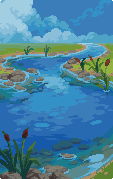
|
Bright glacial waters flow between snowy banks, lined with rimy pebbles and tufts of hardy moss. The glassy water is frigid but beautiful.
|
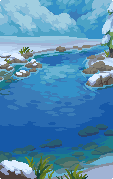
|
| Desert River
|
Shallow Lava
|
| The shining sapphire river fosters an abundance of life; fish dart through the sparkling water, and palms and grasses mass along its banks.
|
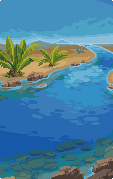
|
This viscous, lucrid river burns a languid path through the ashy wasteland.
|
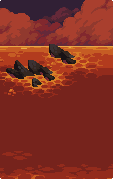
|
| River
|
| Strategy
|
Units placed on river tiles are particularly vulnerable, as this terrain lowers defence. However, choosing to cross a river can often provide a valuable positional advantage.
|
| Statistics
|
Only accessible to those on foot. Units attacked in a river are at a distinct disadvantage
|
| Shallow Lava
|
| Strategy
|
Land- and sea-bound units should avoid shallow lava at all costs in order to avoid instantaneous incineration.
|
| Statistics
|
Airborne units can fly above it, but this terrain is otherwise inaccessible.
| Stats
|
| Hazard: 2
|
1 
|
|
| Grass Bridge
|
Snow Bridge
|
| A broad stone bridge. Though worn and weathered, it remains as strong as the day it was built.
|
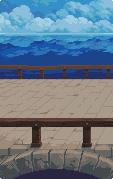
|
A wide bridge crushed with ice, densely packed snow clinging to its weathered stone.
|
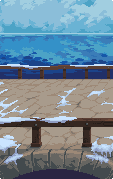
|
| Desert Bridge
|
Volcanic Bridge
|
| The warm stone of this bridge is gritty with fine yellow sand, which fills the shallow cracks between the weathered bricks.
|
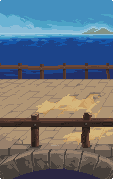
|
An ancient bridge made brittle by the vicious heat of the lava below.
|
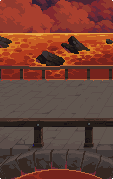
|
| Bridge
|
| Strategy
|
Bridges are a great way to cross river and sea tiles, but can be easily blocked by defensive units. Water units are able to move under bridges at an increased movement cost. If a water unit gets Ambushed when under a bridge, it will be instantly defeated.
|
| Statistics
|
Bridges allow wheeled vehicles to travel quickly over otherwise impassable waters.
|
| Grass Beach
|
Snow Beach
|
| The coast dips gently, and sand stretches out to the sea, falling away to twilight darkness beneath the quiet waves.
|
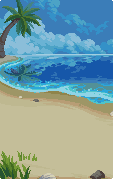
|
Frigid winds blow in off the seas, and chill waves wash between the ice-encrusted rocks.
|
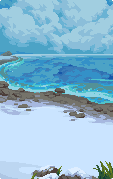
|
| Desert Beach
|
Volcanic Beach
|
| Azure waves kiss golden sand, and a gentle breeze blows in off the sea, taking some heat out of the day.
|
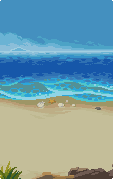
|
Here, at the lava's edge, the ailing rock finally gives way to the savage heat that assails it.
|
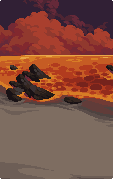
|
| Beach
|
| Strategy
|
Beaches are a vulnerable position for any water unit to occupy, but enable long range naval units to attack deep inland. This is particularly relevant to Warships, which gain a damage boost when occupying a beach.
|
| Statistics
|
Accessible to naval units, Dogs, Amphibians and footsoldiers. Those attacked on the beach are at a disadvantage.
|
| Volcanic Beach
|
| Strategy
|
Beaches are a vulnerable position for any water unit to occupy, but enable long range naval units to attack deep inland. This is particularly relevant to Warships, which gain a damage boost when occupying a beach.
|
| Statistics
|
Accessible to naval units, Dogs, Amphibians and footsoldiers. Those attacked on the beach are at a disadvantage.
|
| Grass Sea
|
Snow Sea
|
| Crystal clear waters where silver-scaled fish flock, and the air is filled with the tang of salt.
|
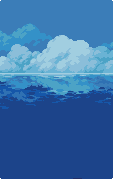
|
Freezing water, vivid blue and bright. The air around is filled with the bite of salt and the raw sharpness of winter air.
|

|
| Desert Sea
|
Lava
|
| Warm, blue, briny water. Just a few feet below the surface, the shifting sunlight dims to shadow, and the water grows cool.
|

|
A luminous sea of molten rock. Intensely, vividly hot, the golden-orange tide seems to set the very air aflame.
|

|
| Sea
|
| Strategy
|
Units in open sea gain a small defensive bonus, but lack the massive increase in speed that they get from deep sea tiles.
|
| Statistics
|
Open water. Accessible only to air and naval units.
|
| Lava
|
| Strategy
|
Land- and sea-bound units should avoid lava at all costs in order to avoid instantaneous incineration.
|
| Statistics
|
Airborne units can fly above it, but this terrain is otherwise inaccessible.
| Stats
|
| Defence: 1
|
1 
|
|
Deep Sea[edit]
| Grass Deep Sea
|
Snow Deep Sea
|
| Clear water grows dark, and the ocean floor gives way to the fathomless deeps.
|

|
The water here is freezing - a chill that penetrates right to the bone. Deep below, the abyssal darkness looms.
|

|
| Desert Deep Sea
|
Deep Lava
|
| A trench of midnight water flows deep below the brightness of the surface.
|

|
Fierce brightness and violent heat assail the air above this roiling flood.
|

|
| Deep Sea
|
| Strategy
|
Naval units in deep sea gain no defence, but move very quickly. Making good use of deep sea tiles is key to winning any maritime skirmish.
|
| Statistics
|
Deep water that allows naval units to move quickly and without hindrance.
|
| Deep Lava
|
| Strategy
|
Land- and sea-bound units should avoid deep lava at all costs in order to avoid instantaneous incineration.
|
| Statistics
|
Airborne units can fly above it, but this terrain is otherwise inaccessible.
| Stats
|
| Defence: 1
|
1 
|
|
| Grass Reef
|
Snow Reef
|
| Barnacled rocks break the swell of the water. Below the surface, the reef teems with life.
|
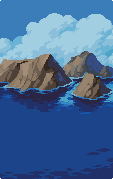
|
Swift, chill currents swirl between the rocks of the reef.
|

|
| Desert Reef
|
Cooling Lava
|
| Rushing water floods between the rocks, throwing a briny spray into the humid air.
|

|
Chunks of fragile rock cool and twist and heat again, floundering in the fiery heat.
|

|
| Reef
|
| Strategy
|
Reef impede movement, but provide some defence. With the exception of Dogs and Turtles, units are unable to see into a reef during fog of war unless they are on an adjacent tile. This makes them the perfect place to set up an Ambush.
|
| Statistics
|
Rocks that lie beneath the sea, slowing but also protecting naval units.
|
| Cooling Lava
|
| Strategy
|
Land- and sea-bound units should avoid cooling lava at all costs in order to avoid instantaneous incineration.
|
| Statistics
|
Airborne units can fly above it, but this terrain is otherwise inaccessible.
| Stats
|
| Defence: 1
|
1 
|
|
| Grass Wall
|
Snow Wall
|
| An impassible bulwark of thick, heavy stone.
|
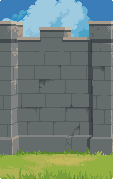
|
An impassible bulwark of thick, heavy stone.
|
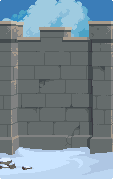
|
| Desert Wall
|
Volcanic Wall
|
| An impassible bulwark of thick, heavy stone.
|
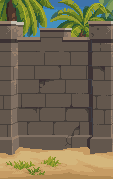
|
An impassible bulwark of thick, heavy stone. The heat hasn't cracked it. Yet.
|
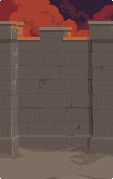
|
| Wall
|
| Strategy
|
Wall tiles are completely impassable. Not even flying units can get over them (these walls must be REALLY tall). Sometimes, they contain gates that can be smashed open to create a point of access.
|
| Statistics
|
While projectiles can travel over walls, units are unable to.
|
Flagstone[edit]
| Grass Flagstone
|
Snow Flagstone
|
| Floor made from solid stone slabs. Built to last the ages.
|
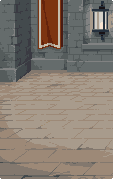
|
Floor made from solid stone slabs. Built to last the ages.
|
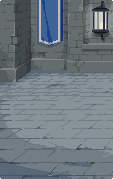
|
| Desert Flagstone
|
Volcanic Flagstone
|
| Floor made from solid stone slabs. Built to last the ages.
|
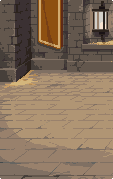
|
Floor made from solid stone slabs. Built to last the ages, but flagging in the heat.
|
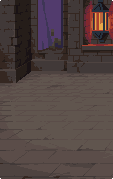
|
| Flagstone
|
| Strategy
|
Flooring that offers footsoldiers, Dogs and Amphibians shelter from wheeled and flying units.
|
| Statistics
|
Accessible to those on foot or horseback, but no one else.
|
| Grass Carpet
|
Snow Carpet
|
| A carpet of woven lambswool. The pile is thick and warm underfoot.
|
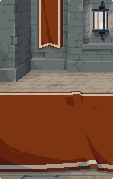
|
A carpet of woven lambswool. The pile is thick and warm underfoot.
|
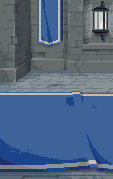
|
| Desert Carpet
|
Volcanic Carpet
|
| A carpet of woven lambswool. The pile is thick and warm underfoot.
|
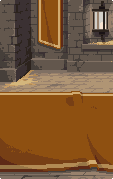
|
A carpet of woven lambswool. The pile is thick and singed.
|
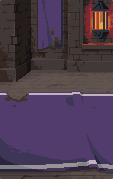
|
| Carpet
|
| Strategy
|
Not discernibly different to a flagstone tile, besides looking a bit grander. Position units here for warm feet and comfy toes.
|
| Statistics
|
A decorative tile that's functionally the same as a flagstone.
|
Corrections[edit]
Not all of the information within the Terrain segment of the Codex is accurate. Below is a set of corrections for inaccuracies.
- Shallow Lava, Deep Lava, and Cooling Lava: the statistics shown incorrently display each of these as having 1 Defence, when they are -2, 0, and 2 respectively. This is not especially relevant as there are no units capable of existing on lava and also receive any of its defence effects.
- Bridge: the information on Ambushes is outdated, and false. Units that stop on an invalid tile (i.e. a naval unit on a bridge) will return to the last available tile safely, instead of being immediately defeated.



















































